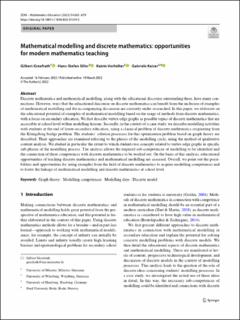| dc.contributor.author | Greefrath, Gilbert | |
| dc.contributor.author | Siller, Hans-Stefan | |
| dc.contributor.author | Vorhölter, Katrin | |
| dc.contributor.author | DR Kaiser, Gabriele Agnes Hildegard | |
| dc.date.accessioned | 2023-03-01T10:16:21Z | |
| dc.date.available | 2023-03-01T10:16:21Z | |
| dc.date.created | 2022-05-31T17:50:26Z | |
| dc.date.issued | 2022 | |
| dc.identifier.citation | Greefrath, G., Siller, H.-S., Vorhölter, K. & Kaiser, G. (2022). Mathematical modelling and discrete mathematics: opportunities for modern mathematics teaching. ZDM: Mathematics Education, 54, 865-879. doi: | en_US |
| dc.identifier.issn | 1863-9704 | |
| dc.identifier.uri | https://hdl.handle.net/11250/3054903 | |
| dc.description.abstract | Discrete mathematics and mathematical modelling, along with the educational discourse surrounding these, have many connections. However, ways that the educational discourse on discrete mathematics can benefit from the inclusion of examples of mathematical modelling and the accompanying discussion are currently under-researched. In this paper, we elaborate on the educational potential of examples of mathematical modelling based on the usage of methods from discrete mathematics, with a focus on secondary education. We first describe vertex-edge graphs as possible topics of discrete mathematics that are accessible at school level within modelling lessons. Secondly, in the context of a case study, we describe modelling activities with students at the end of lower-secondary education, using a classical problem of discrete mathematics originating from the Königsberg bridge problem. The students’ solution processes for this optimisation problem based on graph theory are described. Their approaches are examined referring to the phases of the modelling cycle, using the method of qualitative content analysis. We studied in particular the extent to which students use concepts related to vertex-edge graphs in specific sub-phases of the modelling process. The analysis allows the required sub-competences of modelling to be identified and the connection of these competences with discrete mathematics to be worked out. On the basis of this analysis, educational opportunities of teaching discrete mathematics and mathematical modelling are assessed. Overall, we point out the possibilities and opportunities for using examples from the field of discrete mathematics to acquire modelling competences and to foster the linkage of mathematical modelling and discrete mathematics at school level. | en_US |
| dc.language.iso | eng | en_US |
| dc.publisher | Springer | en_US |
| dc.rights | Navngivelse 4.0 Internasjonal | * |
| dc.rights.uri | http://creativecommons.org/licenses/by/4.0/deed.no | * |
| dc.title | Mathematical modelling and discrete mathematics : opportunities for modern mathematics teaching | en_US |
| dc.type | Peer reviewed | en_US |
| dc.type | Journal article | en_US |
| dc.description.version | publishedVersion | en_US |
| dc.rights.holder | © 2022 The Authors | en_US |
| dc.source.pagenumber | 865-879 | en_US |
| dc.source.volume | 54 | en_US |
| dc.source.journal | ZDM: Mathematics Education | en_US |
| dc.identifier.doi | 10.1007/s11858-022-01339-5 | |
| dc.identifier.cristin | 2028577 | |

